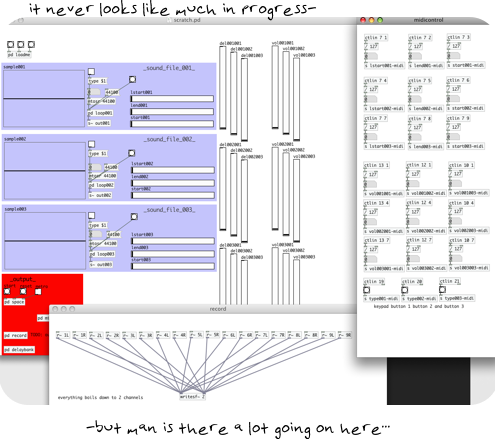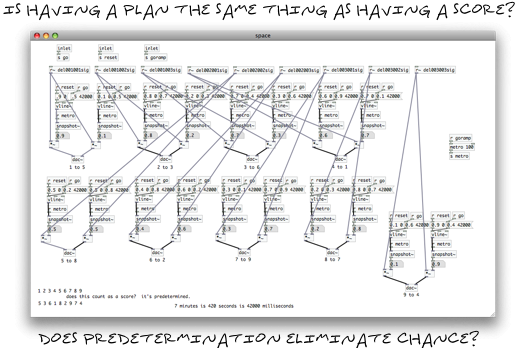I started the Ten Days Project with the hope that the creative block that settles in with the long days and powerful heat of summer could somehow be beaten back and there could be at least a shred of hope that some work, any work could be done before the shadows of late September set in. The idea itself came up in an early morning fog and to be fair, I can’t say that it’s inspiration and execution was anything other than desperate. It wasn’t complicated and there wasn’t any theory or grand list of arcane resources that spawned it.
The fact is that for me, creating music is light on physical reminders. It is with an enormous sense of envy that I have watched painters and sculptors amass piles of materials and stare at them for hours and hours. Yes, with an instrument there is always the reminder, but there are too many things one can do with a guitar. Practicing and improvisation are great, but they don’t necessarily facilitate composing. So I thought about trying to bring a reminder, a talisman, into my daily routine. I bought a three pack of notebooks and started scribbling. The intent was to keep it at hand so that every now and again I would be reminded of the project. The composition would occupy a space in my peripheral vision at all times.
Part of the project was to set a deadline. Having a point in time set at the point when I began the process gave me many things. With a set number of days limits can be imposed almost instantly. There is only so much that can be done and that provides boundaries, something that we too often lack. For the past year, I have been trying to produce a piece of work every week. I had a recording available most Thursdays and that was a pretty good way to do things with sketches. But a full blown piece needs at least 10 days for complete maturity, in my humble opinion. Setting it at 10 days also made it harder to pin it down in my mind. It was a simple trick: if I couldn’t readily assign a day of the week to the deadline, it was harder to procrastinate or skip a day of work.
I decided early on that I wanted to return to Pure Data and some of my roots as a composer of Art Music. That’s my code for “it doesn’t have a beat and you probably can’t bop along to it in the car.” I wanted to do something atmospheric. Turning away from linear time environments like Logic made it easier for me to think in terms of clouds of sounds and textures rather than clock time and measures. I also made the decision to work with real time loop manipulation because I find that entertaining. It provides lots of fodder for improvisation and resists scores. Especially if the sounds being looped are used as textures rather than lines. With that general concept in mind, I took two sound files that I had recorded with my iPhone as a sort of test to see how well it would work with field recordings and used them. They were not edited in any way. I simply loaded them and began to manipulate them.
In all, there were two sound files used but I used one of them twice. That is to say, I loaded three arrays with two sounds. Each array was given three delay lines. That makes nine streams of sound. The length of each delay was set individually and the dynamics of each stream was manipulated independently as well. I used a simple midi fader box to handle these tasks. I also used the midi controller to set the start and end points of the loops. All of these parameters were manipulated in real time.
The streams were positioned on a stereo plane and over the course of seven minutes their positions gradually shifted. This was the only part of the composition that was planned. And by planned I don’t mean to say that I sat down and decided that this tap would be moving from this position to that position on the stereo horizon. I simply decided that this is how the stream would move without any plan to what would be playing at that time. At the time of the recording I had no idea where things were moving in advance. All decisions were made during my recording session.
There was no score for this piece. I thought about making one, but 10 days isn’t a long time. It was enough time for me to build the patch that would do all of the nit picky things like recording the output, etc. That said, in thinking about the patch as an instrument, it made producing certain sounds easier and thus more likely. I suspect that if I had had enough time to really learn the instrument, I could have done far more interesting things with it. But I believe that my inability to devote that kind of time to the in depth study of the patch is more of a positive factor than a detractor.
None of this text or explanation is by any means for you, the reader. It’s blind groping and hope on my part. By all means, take a listen and let me know what you think.
Ten Days Project #1

Ten Days Project #1 by j.c. wilson is licensed under a Creative Commons Attribution-Noncommercial-No Derivative Works 3.0 United States License.
Based on a work at othertime.com.
Permissions beyond the scope of this license may be available at http://othertime.com.



